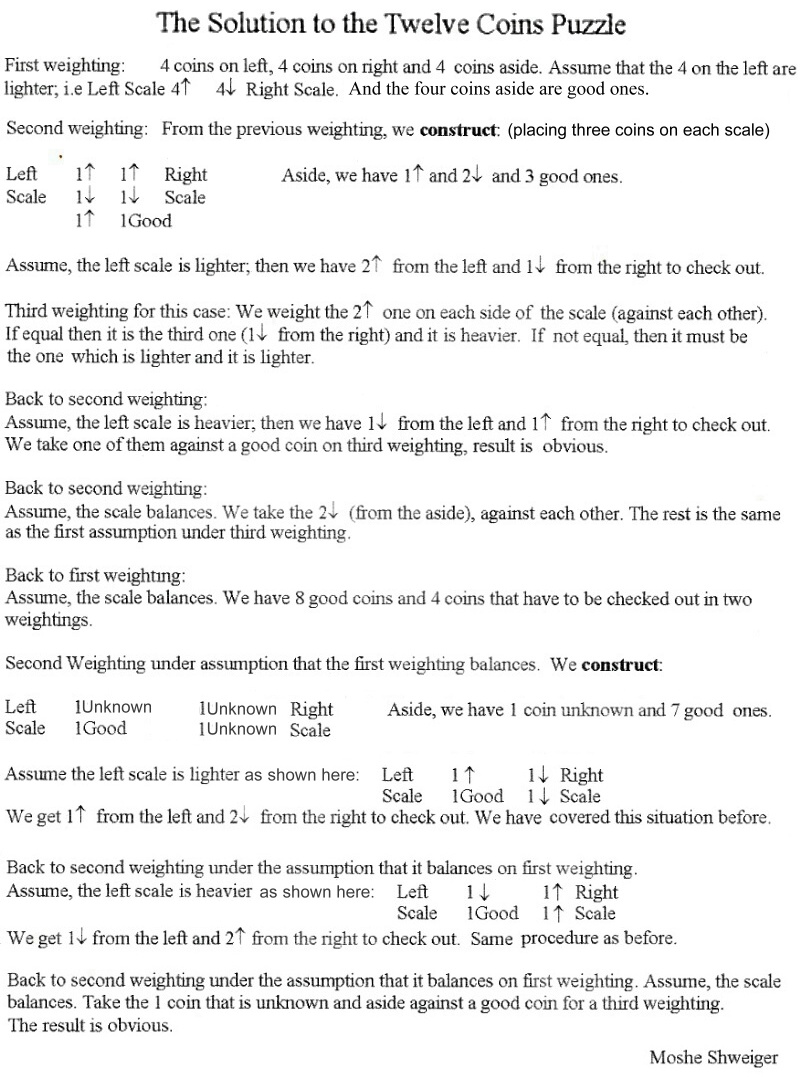| |
First weighing:
Place four coins on each scale of the balance, and
leave the remaining
four coins aside.
FIRST CASE -
The scales are unbalanced
as illustrated below:
Mark the four coins on the light side with an upwards
arrow meaning "Possibly Lighter",
mark the four coins on the heavy side with a
downwards arrow meaning "Possibly
Heavier", and mark the four remaining coins with
the word "GOOD" meaning that their
weights are exactly the same since the fake coin must
be on one of the scales.
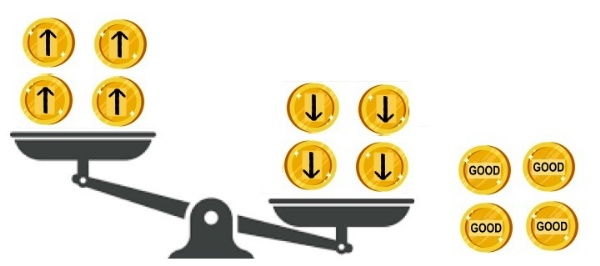
Second
weighing (In the FIRST CASE): Place three coins on
each scale as follows:
Place two coins that are marked as "possibly
lighter" and one coin marked as
"possibly heavier" on one scale, and place
one "GOOD" coin and one each of
"possibly lighter" and "possibly
heavier" coins on the other scale. This leaves
one
"possibly lighter" coin, two "possibly
heavier" coins, and three "GOOD" coins
aside.
If the scales are unbalanced
in this second weighing as illustrated below, perform
a
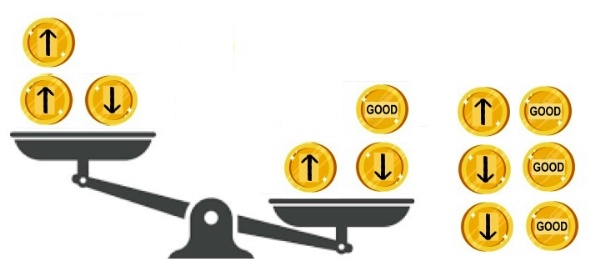
third weighing as follows:
If the
scale with the two "possibly lighter"
coins is lighter as shown
above, then the fake coin must either be one of
the two "possibly
lighter" coins from that lighter side or the
one "possibly heavier"
coin on the other heavier side. Now weigh one of
those two "possibly
lighter" coins against the other.
If this third weighing is balanced,
then the fake coin must be that
"possibly heavier" coin, and it is heavier.
(SOLVED)
But if this third weighing is unbalanced,
then the fake coin must be
the one that is lighter, and it is lighter.
(SOLVED)
If the scale with two "possibly
lighter" coins is heavier as shown below,
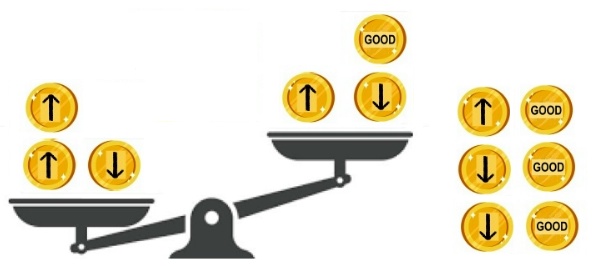
then the fake coin must be either one of the
"possibly heavier" coins
from that heavier side or the one "possibly
lighter" coin on the other
lighter side. Now weigh that "possibly
lighter" coin against a "GOOD"
coin from the asides.
If this third weighing is balanced,
then the fake coin must be that
"possibly heavier" coin not weighed,
and it is heavier.
(SOLVED)
But if this third weighing is unbalanced,
then the fake coin must
be either the one that is lighter, and it is lighter
(SOLVED),
or the
one that is heavier, and it is heavier.
(SOLVED)
If the scales
are balanced
in this second weighing as shown below, then the fake

coin must either be one of the two "possibly
heavier" coins from the asides or
the one "possibly lighter" coin from the
asides. Perform a third weighing as follows:
Weigh the
two "possibly heavier" coins from the
asides against each other.
If this third weighing is balanced,
then the fake coin must be that
"possibly lighter" coin from the
asides, and it is lighter.
(SOLVED)
But if this third weighing is unbalanced,
then the fake coin must be
the one that is heavier, and it is heavier.
(SOLVED)
SECOND
CASE - The scales are balanced
in the first weighing as illustrated below:
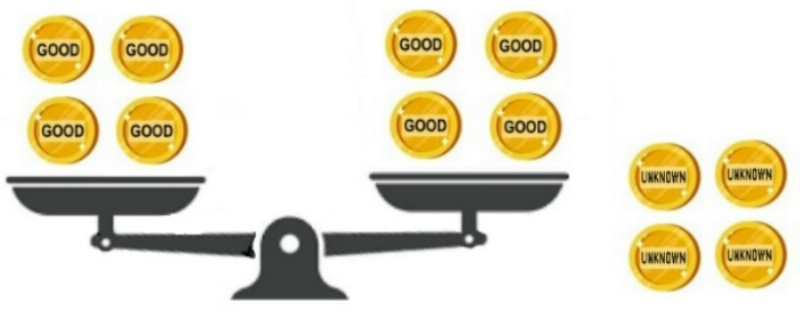
Mark the
eight coins on the scales as "GOOD", and
mark the four coins on the aside
as "UNKNOWN" since they include the fake
coin, and they must be checked in two
more wieghings.
Second weighing (In the SECOND CASE): Place two coins
on each scale as follows:
Place two unknown coins from the asides on one scale,
and one "UNKNOWN" coin
and one "GOOD" coin from the asides on the
other scale. Now one "UNKNOWN"
coin and seven "GOOD" coins remain in the
asides.

If the scales are unbalanced
in this second weighing, perform a third weighing as
follows:
If the
scale with the "GOOD" coin is lighter,
then the fake coin must
either be the "UNKNOWN" coin from that
lighter side or one of the two
"UNKNOWN" coins on the other heavier
side. Now weigh one of those
two "UNKNOWN" coins on the other
heavier side against the other.
If this third weighing is balanced,
then the fake coin must be that
"UNKNOWN" coin from that lighter side,
and it is lighter.
(SOLVED)
But if this third weighing is unbalanced,
then the fake coin must be
the one that is heavier, and it is heavier.
(SOLVED)
If the scales
are balanced
in this second weighing, then the fake coin must be
the
"UNKNOWN" one from the scale with the
"GOOD" coin, but we must determine whether
it is lighter or heavier by the following third
weighing: Weigh the fake coin against a
"GOOD" coin. If the fake coin is lighter,
it is lighter
(SOLVED),
but if the fake coin is
heavier, it is heavier.
(SOLVED)
Moshe
Shweiger
|
 Gem 13: The
Twelve Coins Puzzle - Solutions
Gem 13: The
Twelve Coins Puzzle - Solutions

